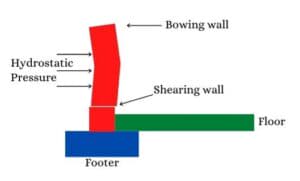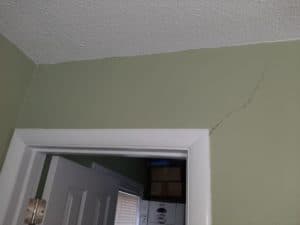
Shearing, hairline, wide, horizontal, drywall, ceiling... What do all these words have in common? They are types of cracks you may find in your home’s foundation that may indicate water damage or settling.
At Acculevel, we specialize in waterproofing and foundation repair. We’re a family-owned and operated company based in Rossville, Indiana. Since our start in 1996, we’ve helped more than 30,000 homeowners restore their homes to health and stability.
In this article, we’re going to review all the different types of cracks you may find in your home. We’ll discuss what they look like, what they mean, and give you resources to help you learn about repair methods for each.
Hairline cracks, as the name suggests, are very thin. They’re usually not much wider than a single hair’s width. They may be short or long, and if they’re all vertical (up & down) cracks, they are probably due to routine causes. This means they’re either from the typical settling of a new home, or the normal expansion and contraction in the foundation.
If you only have a few hairline cracks and they’re dry, they’re not a sign of major trouble. This doesn’t mean you can ignore them; you should still get these repaired as soon as possible. It will be significantly cheaper and easier to repair them now, before they widen and start seeping water.
If you have many hairline cracks—especially if they’re all in the same general location—this is more concerning. You should have your foundation checked for potential problems, and quickly. Scheduling an inspection for foundation repair near you can help prevent further structural damage before it escalates.
Wide cracks are a sign of trouble on the horizon and should be checked by a foundation repair expert. If these cracks aren’t letting in water yet? You’ve been lucky, and should take action before that changes!
At Acculevel, we use epoxy fill to repair foundation cracks. We have worked with crack injection repair methods in the past, but we were dissatisfied with the quality and durability of the repairs. You can learn more about epoxy fill and its uses in this article.
If you have a long horizontal crack in your foundation, you have a serious problem. (If your basement is built of concrete block, you could have a zig-zag or stair step type of crack instead.)

This photo was taken by an Acculevel project advisor during a free estimate appointment. Both horizontal and zig-zag cracks are present, and the wall is beginning to bow inward.
These cracks are caused by hydrostatic pressure. This is a technical way of saying there’s too much water in the soil and it’s pushing against the foundation. If you don’t take steps to repair the wall, the pressure will keep forcing it to move. It will bow inward until it collapses. You should contact a specialist promptly.
Shearing is usually a crack between concrete blocks. You are most likely to see it in a wall that is also bowing (or has bowed in the past). The cause is the same: hydrostatic pressure is pushing against the wall. But this time, the wall isn’t just bowing- it’s sliding. The mortar connection between the first and second block is cracking, allowing the entire wall to shift inward. We have an illustration below.

This illustration was made by the author, who is not a graphic designer.
The best repair method for both shearing and bowing wall cracks is carbon fiber straps. These are also the least expensive repair method, but they only work if the wall is leaning inward less than 2 inches. Acting quickly will save you money and protect the stability of your home.
Not all cracks in your drywall are related to foundation issues. But if they originate at a window or door frame, they could be a sign of settling. The best way to know for certain? Open and close the door or window. You’re looking for instances where it’s a struggle to move it, it won’t stay open without a prop, or it won’t stay closed unless it’s locked. These indicate that there could be a problem with the wooden framework of your house, and that is a sign of settling problems.

This photo was taken by an Acculevel project advisor during a free estimate appointment. This crack, when combined with a sticking door, indicates that the foundation is settling.
Like drywall cracks, ceiling cracks don’t necessarily mean settling issues. But they can be a sign of it. You can test them in a similar fashion; if there’s a crack in the ceiling, check the doors and windows.

This photo was taken by an Acculevel project advisor during a free estimate appointment. This crack, when combined with sticking windows, indicates that the foundation is settling.
You can learn more about the causes and symptoms of a settling foundation, here. The best repair method for settling is helical piers, and we explain why in this article.
We encourage you to read our Thorough Review of Foundation Repair, which is a detailed look at what can go wrong with a home’s basement or crawl space. It covers everything: what causes an issue, how to repair it, what the repairs cost, and how to protect and preserve your home long-term.
If you need to schedule an appointment with a foundation expert, contact Acculevel. One or our knowledgeable and experienced project advisors will meet with you, discuss your concerns, fully evaluate your home, and provide you with a detailed written estimate for a whole-home solution. We will treat your home as if it were our own, and provide you with five star customer service every step of the way.
If you don’t live in our service area, speak with your friends and neighbors about referrals to good local contractors. You can also check with Home Advisor, your HOA, or the realtor who sold your home.
[DISPLAY_ULTIMATE_SOCIAL_ICONS]